Linear Inequalities
Get insights from 69 questions on Linear Inequalities, answered by students, alumni, and experts. You may also ask and answer any question you like about Linear Inequalities
Follow Ask QuestionQuestions
Discussions
Active Users
Followers
New question posted
5 months agoNew answer posted
5 months agoContributor-Level 10
51. The given system of inequality is
x+2y≤ 10- (1)
x+y≥ 1 - (2)
x – y ≤ 0 - (3)
x≥ 0 and y≥ 0 - (4)
The corresponding equation of (1), (2) and (3) are
x + 2y = 10
x | 0 | 10 |
y | 5 | 0 |
and x + y =1
x | 0 | 1 |
y | 1 | 0 |
and x – y = 0
x | 0 | 1 |
y | 0 | 1 |
Putting (2,0)= (x, y) in inequality (1), (2) and (3),
2+2 * 0 ≤ 10 => 2≤ 10 is true.
and 2+0 ≥ 1 => 2 ≥ 1 is true.
and 2 – 0 ≤ 0 => 2 ≤ 0 is false.
So, the solution of inequality (1) and (2) is the plane that includes point (2,0) whereas the solution of inequality (3) is the plane which includes point (2, 0)
∴ The shaded region represents the solution of the given system of inequality.
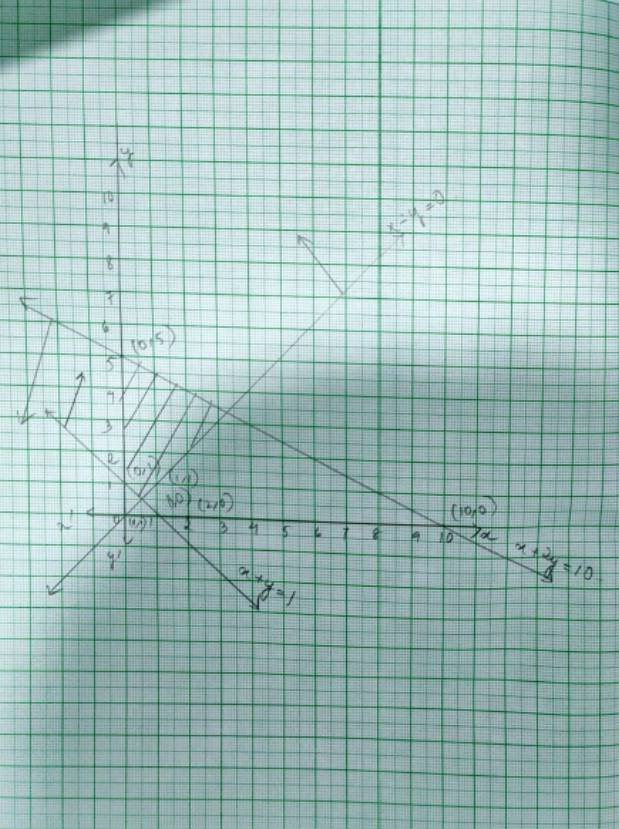
New answer posted
5 months agoContributor-Level 10
50.The given system of inequality is
3x+2y≤ 150- (1)
x+4y≤ 80- (2)
x≤ 15 - (3)
y≥ 0 and x≥ 0 - (4)
The corresponding equation of (1) and (2) are
3x + 2y = 150
x | 50 | 0 |
y | 0 | 75 |
and x + 4y =80
x | 0 | 40 |
y | 20 | 10 |
Putting (0,0)= (x, y) in inequality (1) and (2) we get,
3 * 0+2 * 0 ≤ 150 => 0 ≤ 150 is true.
and 0+4 * 0 ≤ 80 => 0 ≤ 80 is true.
So, the solution plane of both inequality (1) and (2) includes the origin (0,0).
∴ The shaded region is the solution of the given system of inequality.
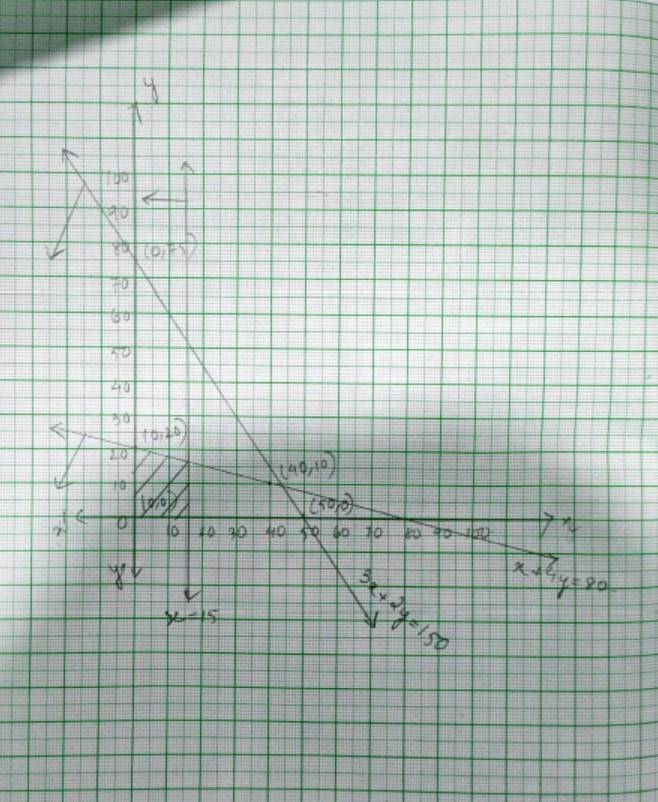
New answer posted
5 months agoContributor-Level 10
49. The given system of inequality is
4x+3y≤ 60- (1)
y≥ 2x- (2)
x≥ 3- (3)
andx, y ≥ 0- (4)
The corresponding equation of inequality (1) and (2) are
4x+3y= 60
x | 0 | 15 |
y | 20 | 0 |
and y = 2x
x | 0 | 1 | 2 |
y | 0 | 2 | 4 |
Putting (1,0) in inequality (1) and (2) we get,
4 * 1+3 * 0 ≤ 60
4 ≤ 60 which is true.
and 0 ≥ 2 * 1
0 ≥ 2 which is false.
So, solution of inequality (1) includes the plane with point (1,0) whereas the solution of inequality (2) excludes the plane with point (1,0).
? The shaded region is the solution of the given system of inequality.
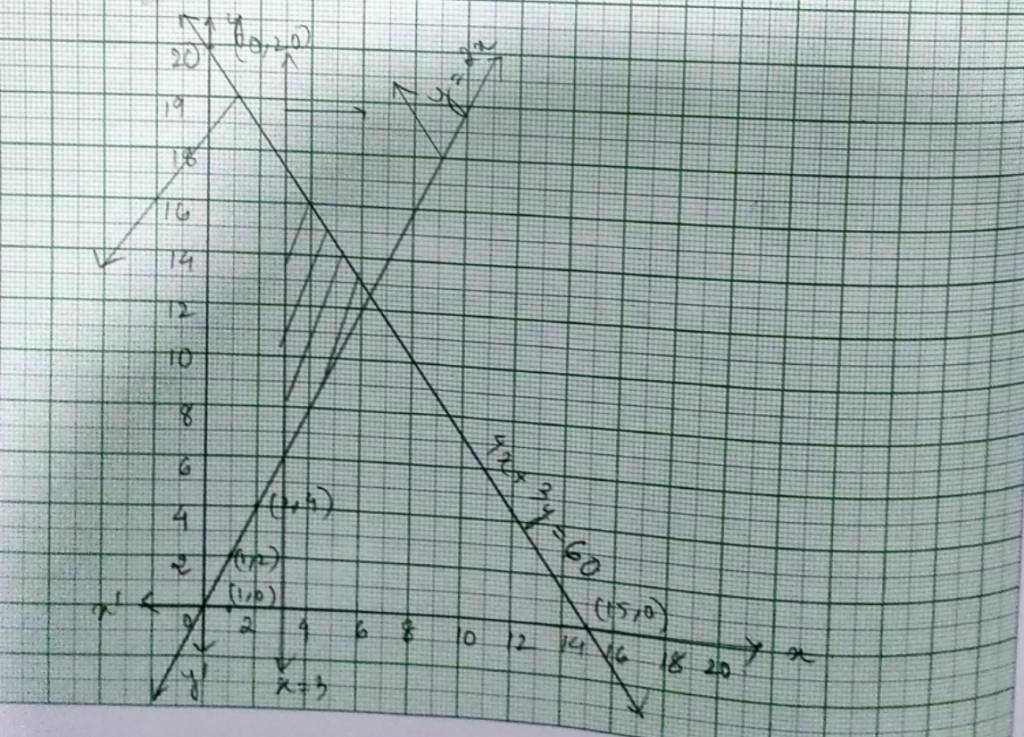
New answer posted
5 months agoContributor-Level 10
48. The given system of inequality is
x – 2y≤ 3 - (1)
3x – 4y≥12- (2)
x ≥ 0 - (3)
y≥ 1 - (4)
The corresponding equation of (1) and (2) are
x – 2y= 3
x | 3 | 0 |
y | 0 | –1.5 |
and 3x – 4y=12
x | 4 | 0 |
y | 0 | 3 |
Putting (x, y)= (0,0) in inequality (1) and (2),
0 – 2 * 0 ≤ 3 => 0 ≤ 3 is true.
and 3 * 0+4 * 0 ≥ 12 => 0 ≥ 12 is false.
So, solution of inequality (1) includes plane wilt origin (0,0) while solution plane of inequality (2) includes the origin.
∴ The shaded portion determines the solution region of the given system of inequality.
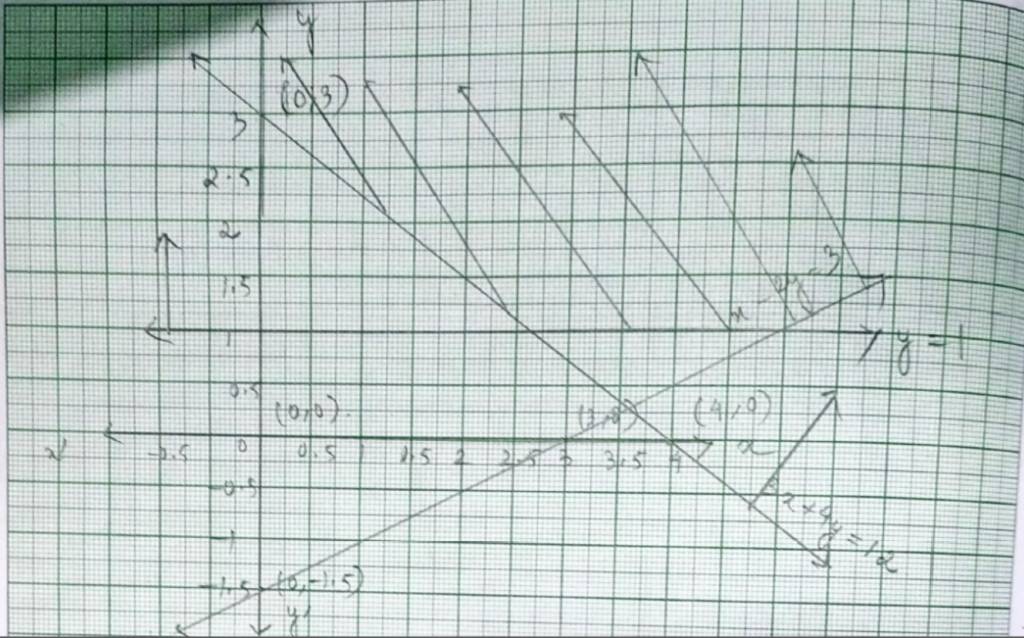
New answer posted
5 months agoContributor-Level 10
47. The given system of inequality is
2x + y ≥ 4- (1)
x + y ≤ 3- (2)
2x – 3y ≤ 6- (3)
The corresponding equation are
2x + y = 4
x | 2 | 0 |
y | 0 | 4 |
and x + y = 3
x | 0 | 3 |
y | 3 | 0 |
and 2x + 3y = 6
x | 3 | 0 |
y | 0 | –2 |
Putting (x, y)= (0,0) in (1), (2) and (3),
2 * 0+0 ≥ 4
0 ≥ 4 which is false.
and 0+0 ≤ 3 => 0 ≤ 3 which is true.
and 2 * 0 – 3 * 0 ≤ 6 => 0 ≤ 6which is also true.
So, solution of inequality (1) excludes plane with origin while solution of inequality (2) and (3) includes the plane with origin.
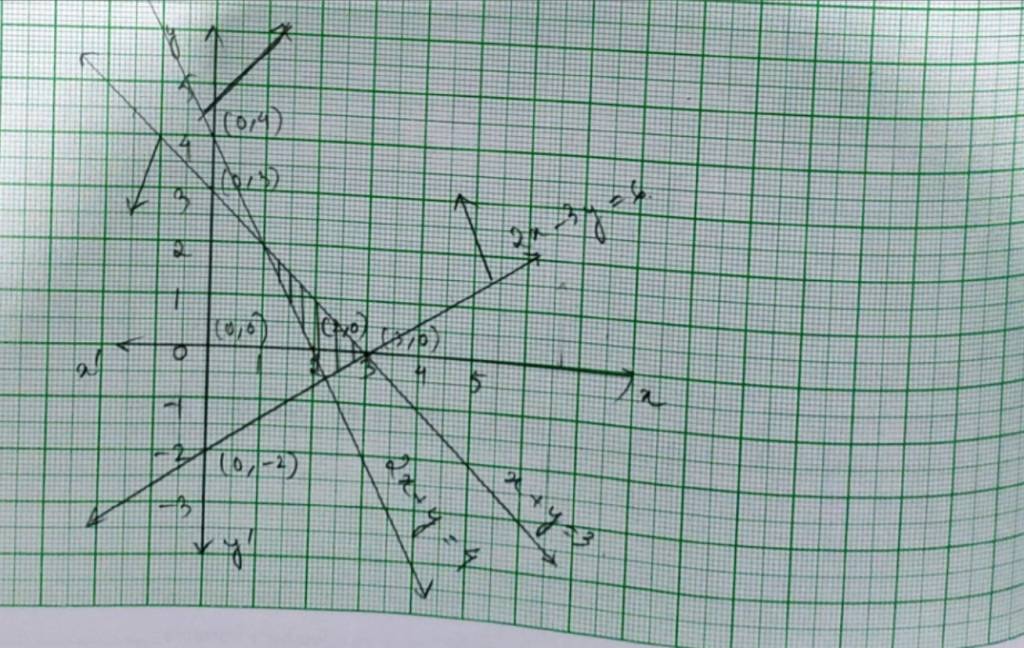
New answer posted
5 months agoContributor-Level 10
46. The given system of inequality is
3x+4y ≤ 60 - (1)
x+3y ≤ 30- (2)
x≥ 0 - (3)
xy≥ 0 - (4)
The corresponding equation of (1) and (2) are
3x + 4y = 60
x | 20 | 0 |
y | 0 | 15 |
and x + 3y = 30
x | 0 | 30 |
y | 10 | 0 |
Putting (x, y)= (0,0) in equality (1) and (2),
3 * 0+4 * 0 ≤ 60 and 0+3 * 0 ≤ 30
0 ≤ 60 which is true and 0 ≤ 30 which is true
So, the solution plane of inequality (1) and (2) is the plane including origin (0,0)
∴ The shaded portion is the solution of the given system of inequality.
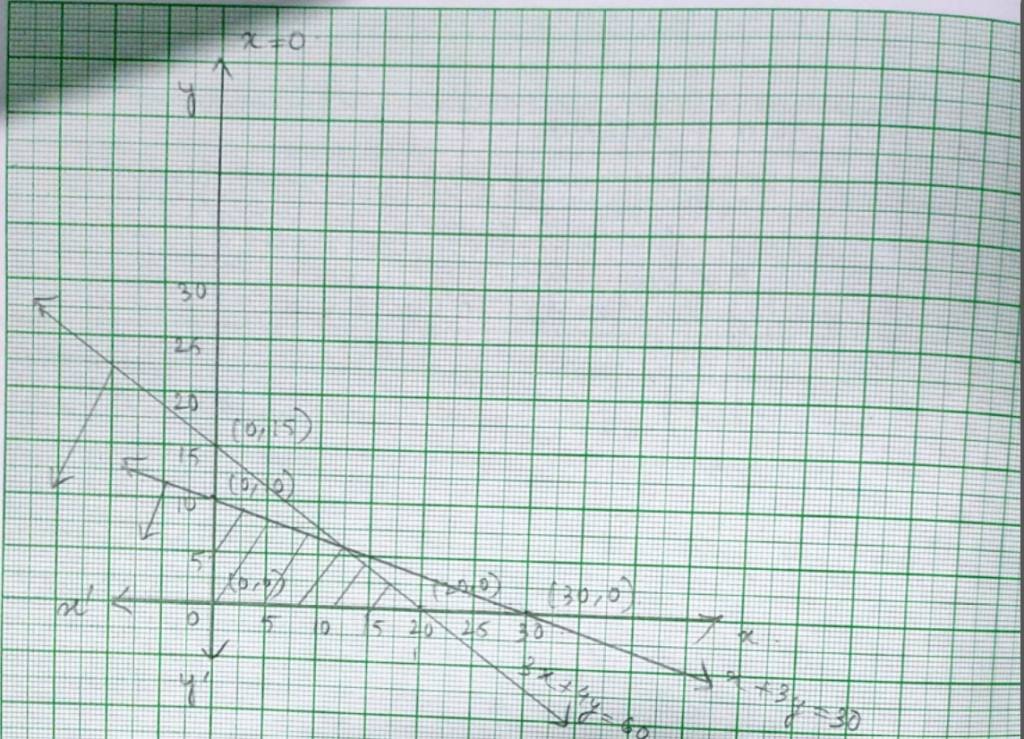
New answer posted
5 months agoContributor-Level 10
45. The given system of inequality is
5x+4y≤ 20 - (1)
x≥ 1 - (2)
and y≥ 2 - (3)
The equation of inequality (1) is 5x+4y=20.
x | 4 | 0 |
y | 0 | 5 |
Putting (x, y)= (0,0) in inequality (1) we get,
5 * 0+4 * 0 ≤ 20 => 0 ≤ 20 which is true.
So, the solution region of inequality (1) includes the plane with origin (0,0).
∴ The shaded region indicates the solution of the given system of inequality.
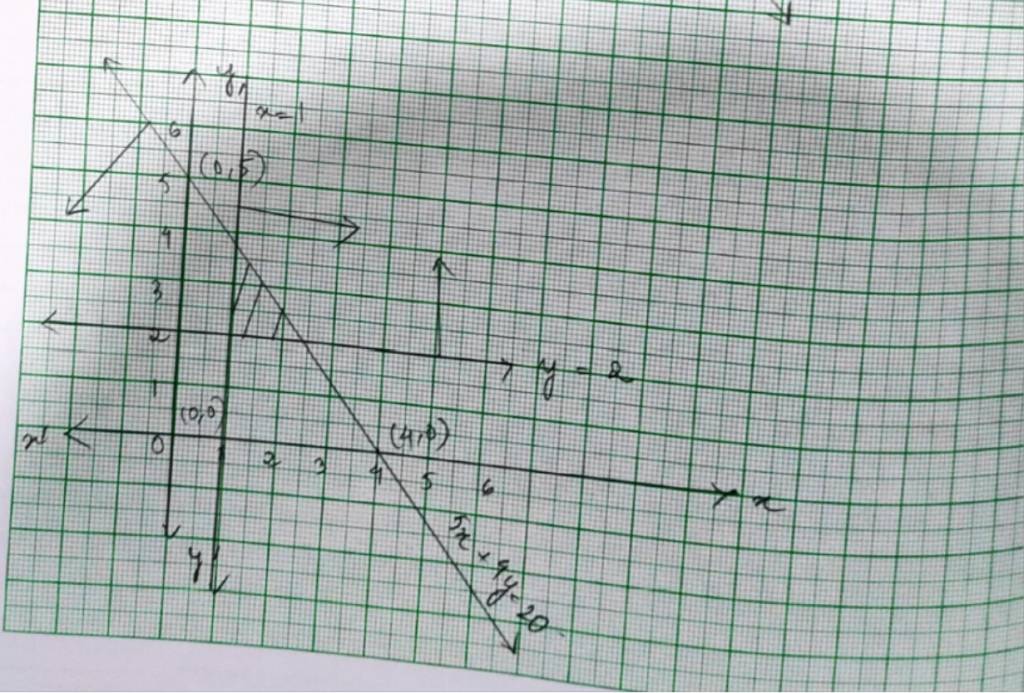
New answer posted
5 months agoContributor-Level 10
44. The given system of inequality is
x+y≤ 9- (1)
y>x- (2)
x≥ 0 - (3)
The corresponding equation of (1) is x+y=9 and (2) is y=x
x | 9 | 0 |
y | 0 | 9 |
x | 0 | 1 |
y | 0 | 1 |
Substituting (x, y)= (0,0) in (1),
0+0 ≤ 9 => 0 ≤ 9 which is true.
And putting (1,0) in (2)
0> 1which is false.
So, solution region of inequality (1) includes origin (0,0) and solution region of inequality (2) excludes plane having (1,0).
? Solution of region of given system of inequality is the shaded region.
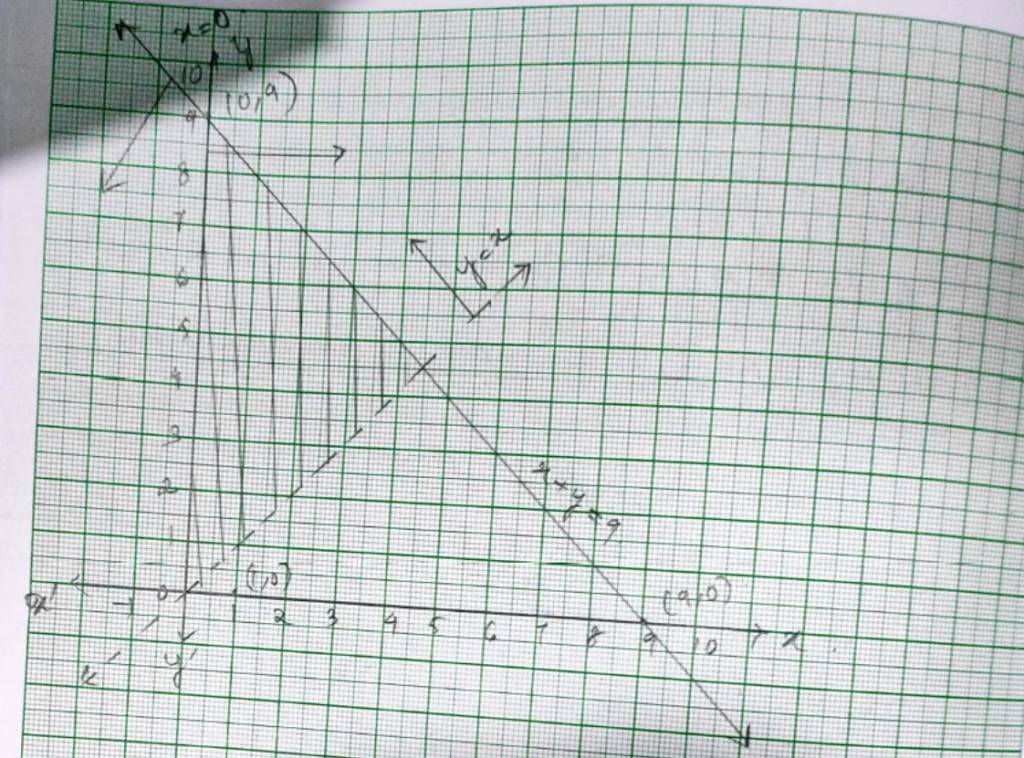
New answer posted
5 months agoContributor-Level 10
43. Given system of inequality is
2x+y≥ 8- (1)
x+2y≥ 10- (2)
The corresponding equations are
2x + y = 8
x | 0 | 4 |
y | 8 | 0 |
and x + 2y = 10
x | 10 | 0 |
y | 0 | 5 |
Now, putting (x, y)= (0,0) in inequality (1) and (2),
2 * 0+8 ≥ 8
0 ≥ 8 which is not true.
and 0+2 * 0 ≥ 10
0 ≥ 10 which is not true.
So, solution of plane of inequality (1) and (2) does not include the origin (0,0)
? The required solution of the given system of inequality is the shaded region.
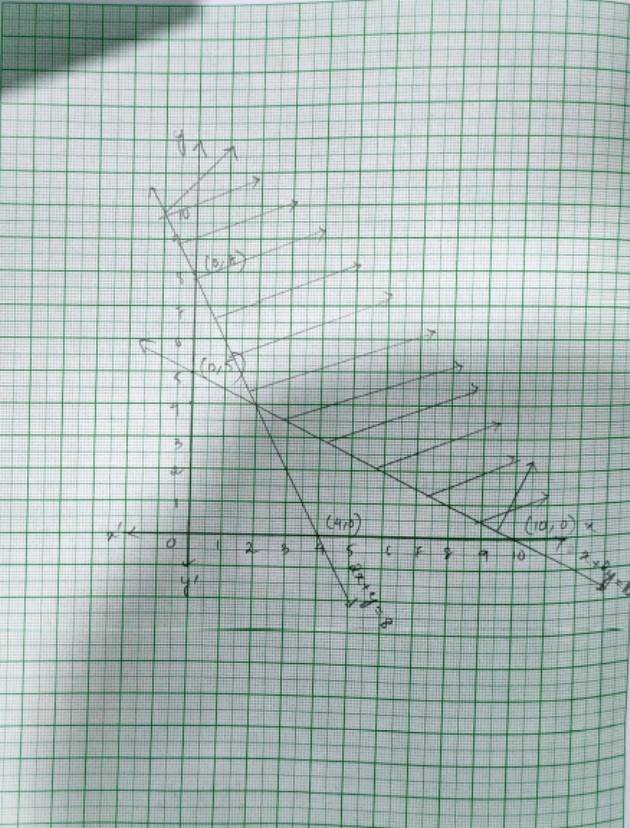
Taking an Exam? Selecting a College?
Get authentic answers from experts, students and alumni that you won't find anywhere else
Sign Up on ShikshaOn Shiksha, get access to
- 65k Colleges
- 1.2k Exams
- 679k Reviews
- 1800k Answers
